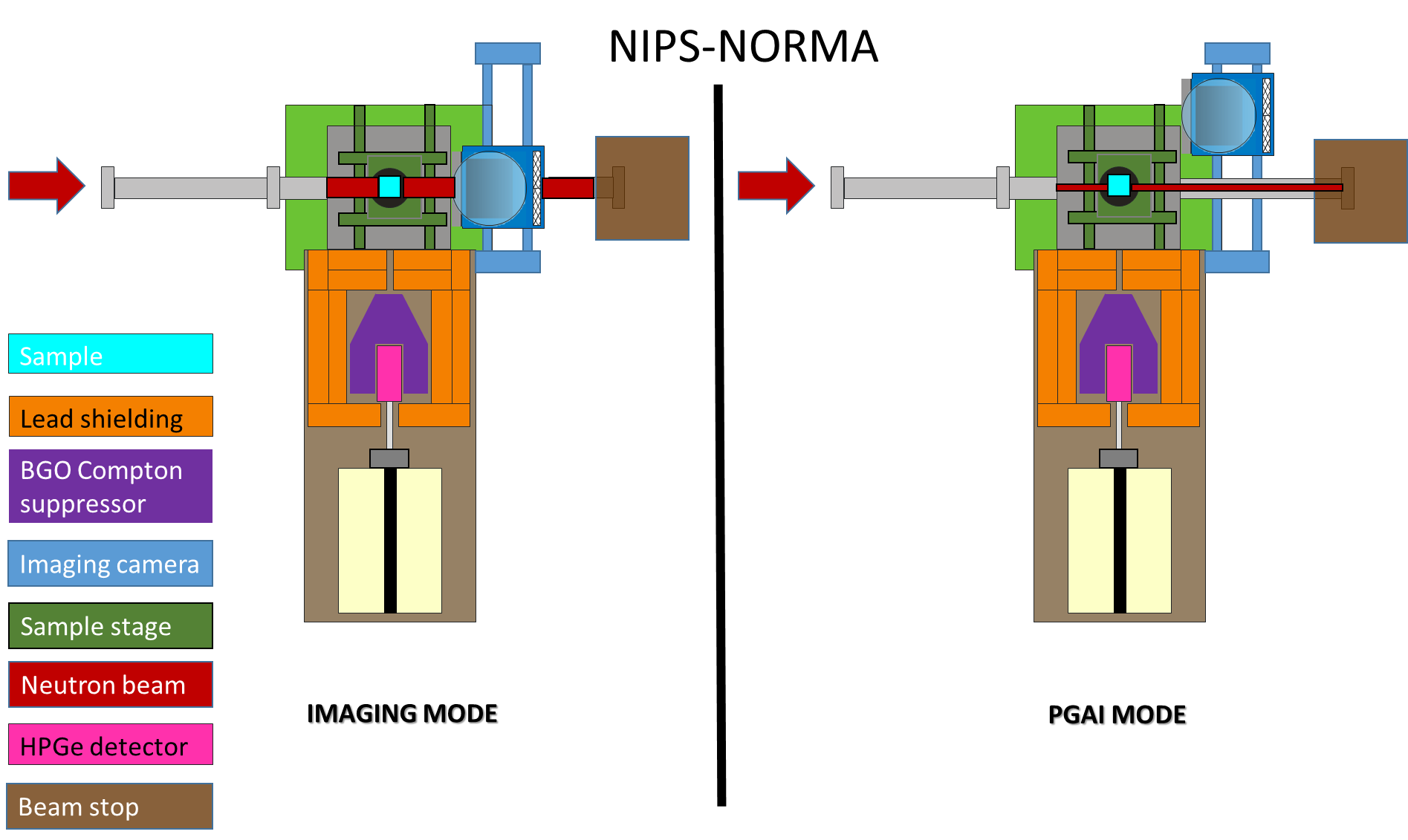NIPS
NIPS - Neutron-Induced Prompt Gamma-ray Spectroscopy
Instrument responsible: László Szentmiklósi, Zoltán Kis
Contact: nips@bnc.hu
The NIPS facility is located at the end position of the neutron guide No.10/1. It is used for large-sample PGAA, position-resolved element analysis with Prompt-Gamma Activation Imaging (PGAI), with or without the neutron imaging part NORMA.

From the cold neutron source of the Budapest Research Reactor, the neutrons are guided to the experimental positions by the same curved neutron guides as for the PGAA facility. Before the beam enters the experimental area, the beam is divided into two sub-beams (upper and lower) by suitable collimators, and the lower one operates the NIPS facility. The thermal-equivalent neutron flux at the NIPS sample positions is 2.7×107 cm–2 s–1. The beam could be collimated to a maximum cross-section of 4×4 cm2. The intensity of the incoming neutron flux is monitored and recorded with an ORDELA Model 4511 N neutron detector throughout the whole reactor campaign.
The beam arrives through a flight tube of 5×5 cm2 cross-section. A sample chamber with dimensions of 20×20×20 cm3 is available for large-sample PGAA and position-sensitive applications. It is made of AlMgSi alloy and lined from inside with 6Li-enriched polymer. By removing one or more side panels, larger objects up to 5 kg weight could also be analyzed (such as a sword, vase, stones, etc.). Samples can be loaded manually from the top, or placed onto an XYZω motorized sample stage with a travel distance of 200 mm and a guaranteed precision of 15 μm, which is introduced from the bottom. If custom devices are to be built into the beam, a short flight tube without a sample chamber is the proper choice.
An n-type coaxial HPGe detector (Canberra GR 2318/S) equipped with a Scionix BGO Compton suppressor is used for the routine prompt gamma measurements. This latter can accommodate HPGe detectors with larger crystals (up to end cap diameter of 76 mm). The passive shielding is made of standard lead bricks with a thickness of 10 cm for each direction. A changeable gamma collimator system is available for PGAI measurements consisting of three different lead collimators with an opening of 30 mm in diameter, a 2×20 mm2 slit, and a 5×5 mm2, respectively. The gamma detector systems are regularly calibrated for counting efficiency and non-linearity. This procedure results in a precision of about 0.5% for the relative efficiency curve, 1% for the absolute efficiency curve, and a precision of 0.005-0.1 keV for the energy determination of peaks. The complex gamma-ray spectra are evaluated with the spectroscopy program Hypermet-PC. Optionally a Low-energy Germanium detector (LEGe) can be installed within the BGO for high-resolution measurement of a few hundred keV gammas, best applicable to the analysis of metals.
A state-of-the-art digital gamma spectrometer (Ortec DSPEC 502A) collects the counts in 64k histogram channels. Alternatively, a four-channel, all-digital XIA Pixie4 or a CAEN N6730 digitizer can also be used for list-mode nuclear physics measurements. A user-friendly control program is available for manual, semi-automatic, and unattended automatic batch measurements. It controls the beam shutters, slits, the motorized sample stage, and the gamma acquisition.
|
Beam tube: |
NG1 guide, end position |
|
Distance from guide end: |
2.6 m |
|
Beam cross-section for PGAA/PGAI: |
continuously adjustable rectangular slit |
|
Beam cross-section for imaging: |
up to 40×40 mm2 |
|
Thermal-equivalent flux at target: |
2.7×107n cm-2s-1 |
|
Vacuum in target chamber: |
Not available |
|
Form of target at room temperature: |
Solid, powder, liquid; gas in a pressurized container |
|
Target packing at atmospheric pressure: |
sealed FEP Teflon bag or vial |
|
Sample chamber dimensions: |
20×20×20 cm3 |
|
Distance from target to detector window: |
280 mm |
|
Gamma-ray detector |
n-type coax. HPGe, with BGO shield |
|
HPGe window: |
Al, 0.5 mm |
|
Relative efficiency: |
23% at 1332 keV (60Co) |
|
FWHM: |
1.9 keV at 1332 keV (60Co) |
|
Compton-suppression factor |
about 3.5 (1332 keV) to 30 (7000 keV) |
Table 1. Specifications of NIPS facility

Figure 1. The configuration of the NIPS experimental station. The coupled NORMA imaging station can be used for radiography-driven local element analysis.
Reference
L Szentmiklósi, Z Kis, T Belgya, AN Berlizov. (2013) On the design and installation of a Compton-suppressed HPGe spectrometer at the Budapest neutron-induced prompt gamma spectroscopy (NIPS) facility. J Radioanal Nucl Chem. 298(3):1605-11. DOI: 10.1007/s10967-013-2555-2
L. Szentmiklósi, Zs. Révay, J. Östör, B. Maróti, Improved analytical workflow for prompt gamma activation analysis. J Radioanal Nucl Chem (2023). https://doi.org/10.1007/s10967-023-09071-4
